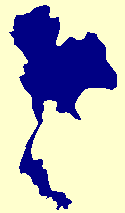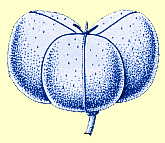
Flora of Thailand
Euphorbiaceae

 |
|
 |
The website deviates from the Flora of Thailand (based on Yu et al., Taxon 68, 2019, 918936), where Tritaxis is still treated as Dimorphocalyx.
K. Phattarahirankanok, K. Chayamarit, R.Y. Yu, F.J.W. Slik & P.C. van Welzen
Goto on this page:
Baill., Ιtude Euphorb. (1858) 342; Benth. in Benth. & Hook.f., Gen. Pl. 3 (1880) 292; Pax in Engl., Planzenr. IV.147 (1910) 113; R.Y.Yu, Slik & Welzen, Taxon 68 (2019) 932. Dimorphocalyx Thwaites, Enum. Pl. Zeyl. 278. 1861; Hook.f., Fl. Brit. Ind. 5: 403. 1887; Pax & K.Hoffm. in Engl., Pflanzenr. IV.147.iii: 31. 1911; Airy Shaw, Kew Bull. 26: 251. 1972; Whitmore, Tree Fl. Malaya 2: 86. 1973; Brandis, Ind. Trees: 581. 1978; Airy Shaw, Kew Bull. 35: 624. 1980; Kew Bull. 36: 286. 1981; G.L.Webster, Ann. Missouri Bot. Gard. 81: 106. 1994; Philcox in Dassan., Fl. Ceyl. 11: 107. 1997; Radcl.-Sm., Gen. Euphorbiacearum: 300. 2001; Phattar. & Chayam. in Chayam. & Welzen, Fl. Thailand 8, 1: 229. 2005; G.L.Webster in Kubitzki, Fam. Gen. Vasc. Pl. 11: 174. 2014. Trigonostemon Blume sect. Tritraxis (Baill.) Mόll.Arg., Linnaea 34 (1865) 213; in DC., Prodr. 15, 2 (1866) 1107.
Tree or shrub, dioecious (or monoecious); bark smooth; latex absent. Indumentum simple hairs on new parts and flowers. Stipules triangular, short, caducous. Leaves alternate, simple, petiolate; blade coriaceous, margin entire to serrate, with or without glands beneath. Inflorescences axillary to terminal, unisexual, with a single to few flowers in cymes, corymbs or racemes. Flowers symmetric, pedicellate; calyx 5-lobed, imbricate; petals 5, white. Staminate flowers: sepals cup-shaped; disc glands 5, alternipetalous; petals longer than sepals; stamens 1022 in 2 whorls, outer free, inner united, anthers with 2 thecae; pistillode absent. Pistillate flowers: sepals chataceous, in some species accrescent in fruit; petals shorter than calyx lobes when accrescent, membranous; disc annular; ovary 3-locular; ovules 1 per locule; style absent to short, stigmas stout, appically bifid. Fruits capsular, 3-lobed, septicidally dehiscent into 2-valved cocci; columella subcapitate, persistent. Seeds brown; ecarunculate.
Twelve species in tropical Asia, ranging from India and Sri Lanka to Hainan, the Philippines, Moluccas, and Lesser Sunda Islands, one species up to Australia. In Thailand 2 species. Classification: Subfam. Crotonoideae, tribe Codiaeae.
|
1a. |
Leaves entire. Fruit smooth (unarmed); calyx accrescent. |
|
|
1b. |
Leaves obscurly serrate. Fruit muricate, calyx not accrescent |
1. Tritaxis malayana (Hook.f.) R.Y.Yu & Welzen in R.Y.Yu et al., Taxon 68 (2019) 933. Dimorphocalyx malayanus Hook.f., Fl. Brit. Ind. 5: 404. 1887; Whitmore, Fl. Malay Pen. 2: 86. 1973; Phattar. & Chayam. in Chayam. & Welzen, Fl. Thailand 8, 1: 229, fig. 50. 2005. Dimorphocalyx luzoniensis Merr., Philipp. J. Sc. 5, Bot. (1910) 192.. Dimorphocalyx kunstleri King ex Hook.f., Fl. Brit. Ind. 5: 405. 1887; Ridl., Fl. Mal. Pen. 2: 266. 1924. Dimorphocalyx beccarii Gagnep., Bull. Soc. Bot. France 71: 621. 1924. Trigonostemon bulusanensis Elmer, Leafl. Philipp. Bot. 10 (1939) 3735. Dimorphocalyx bulusanensis (Elmer) Airy Shaw, Kew Bull. 27 (1972) 92.
Shrub or tree 57 m high; bark smooth, white-grey. Stipules triangular, c. 1 by 1 mm. Leaves: petiole 0.81 cm long; blade o usually elliptic, 8.5-13 by 2.54.5 cm, glabrous, base cuneate, margin entire, with glands beneath, apex acute, nerves 810 pairs, midrib prominent on both sides. Staminate inflorescences cymes or corymbs, (2)37(10.5) cm long, pedunculate; pistillate inflorescences simple flowered or corymbs, 12 cm long. Staminate flowers 35 mm in diameter; pedicel 812 mm long; sepals connate at base, oblong, c. 2.5 by 1 mm; petals oblong, c. 6 by 3 mm; stamens 11 or 12, outer free (to united), inner united, filaments 23 mm long, anthers oblong, c. 0.6 x 0.5 mm, yellow. Pistillate flowers: pedicels 11.6 cm long, sepals oblong to obovate, 510 by 46 mm, accrescent in fruit up to 817 by 58 mm, apex obtuse, green; petals oblong, c. 5 by 3 mm, membranous, glabrous; ovary subglobose, ca. 2 mm in diameter, glabrous; style stout, rigid dark brown, c. 2 mm long. Fruit c. 10 by 67 mm, glabrous. Seeds ovoid, c. 5 by 3 mm.
T h a i l a n d. PENINSULAR: Songkhla (Ton-Nga-Chang), Narathiwat (Bajo, Khao Tan Yong).
D i s t r i b u t i o n. India, Thailand, Malay Peninsula (type), Borneo.
E c o l o g y. Common on slopes in evergreen forest. Altitude: 50200 m. Flowering: MarchMay; fruiting: JuneAugust.
V e r n a c u l a r. Khem yai (เข็มใหญ่) (Songkhla).
2. Tritaxis muricata (Hook.f.) R.Y.Yu & Welzen in R.Y.Yu et al., Taxon 68 (2019) 933. Ostodes muricatus Hook.f., Fl. Brit. Ind. 5: 401. 1887. Ostodes muricata Hook.f. var. ? minor Hook.f., Fl. Brit. Ind. 5 (1887) 401. Trigonostemon asahanensis Croizat, J. Arnold Arbor. 23: 54. 1942. Dimorphocalyx muricatus (Hook.f.) Airy Shaw, Kew Bull. 20: 412. 1966; Kew Bull. 26: 252. 1972; Whitmore, Tree Fl. Malaya 2: 87. 1973; Airy Shaw, Kew Bull. 36: 286. 1981; Kew Bull. 37: 16. 1982; Kew Bull. Add. Ser. 4: 97. 1975; Phattar. & Chayam. in Chayam. & Welzen, Fl. Thailand 8, 1: 231, fig. 51, plate XIII: 1. 2005. Dimorphocalyx muricatus (Hook.f.) Airy Shaw var. minor (Hook.f.) Airy Shaw, Kew Bull. 20: 412. 1966.
Tree up to 10 m high; bark rather smooth, pale grey. Stipules triangular, ca. 4 by 3 mm. Leaves: petiole 3.5 cm long; blade (ovately) elliptic, 2024 by 810 cm, chartaceous, glabrous, base cuneate, margin serrulate with gland in each tooth, apex acute or acuminate; nerves 1012 pairs, midrib prominent on both sides. Inflorescences corymbs; staminate ones up to 10 cm long; pistillate ones up to 8 cm long. Staminate flowers 11.5 cm in diameter; pedicel 0.81 cm long; sepals cup-shape, ca. 1 by 0.2 cm, pubescent outside; petals oblong, c. 8 by 3 mm, glabrous; stamens 1422, filaments 25 mm long, partly united; anthers c. 1 by 0.8 mm. Pistillate flowers 11.2 cm in diameter; pedicels 0.71 cm long; sepals basally connate, oblong, c. 3 x 2 mm, pubescent outside, not accrescent in fruit; petals oblong, c. 4 by 3 mm, glabrous; ovary subglobose to ovoid, c. 3.5 by 23 mm, muricate; style stout, 2.53 mm long. Fruits subglobose, 2.52.8 cm in diameter, muricate. Seeds obovoid, c. 8 by 5 mm.
Fruits subglobose, 2.52.8 cm diam., covered with muricate
T h a i l a n d. PENINSULAR: Narathiwat (Waeng).
D i s t r i b u t i o n. Peninsular Thailand, Malay Peninsula incl. Singapore (type), Sumatra, Borneo, Moluccas.
 l
=
T. muricata
(«=
T. ixoroides)
l
=
T. muricata
(«=
T. ixoroides)
E c o l o g y. Scattered in evergreen forest up to 500 m.
V e r n a c u l a r. Mu yo ni ka (มูโย๊ะนีกา) (Malay-Narathiwat).